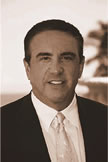|
 Home: PCU
2|2003: Editor's note
Home: PCU
2|2003: Editor's note
 |
Editor’s Note |
|
| A Day at the
Clinic |
Mark Soloway’s annual “Challenging Cases in Urology”
meeting held each year in Miami has truly set a new standard for
education in the field over the last 13 years. His innovative use
of interactive case discussions yields a vivid portrait of practice
patterns. To give our listeners who were unable to attend the conference
a glimpse into the some of the highlights, I asked Dr Soloway to
bring to our interview session some of the more controversial cases
he has discussed over the years.
However, he surprised me by pulling from his pocket a list of
patients he had seen the day before. I appreciated the subtle point
he was making — every patient with prostate cancer poses unique
challenges. Not surprisingly, the cases Dr Soloway selected to discuss
on the program are very provocative. If you have any comments or
wish to tell him what you would have recommended to these men, please
email me at NLove@med.miami.edu.
We will select some of your responses to discuss when we follow-up
the cases later this year.
— Neil Love, MD
Cases presented by Dr Soloway
on the enclosed program
->Case
#1, Age 60. Prior history of testicular
cancer in 1977 treated with a right orchiectomy and retroperitoneal
node dissection. In 1982, the patient was treated with a left
orchiectomy and chemotherapy for a second testicular cancer.
He currently receives testosterone replacement. Patient has
a PSA of 5 ng/mL and Gleason 6 prostate cancer.
Key question:
Should a radical prostatectomy be performed in a patient with
a prior retroperitoneal node dissection? Should the testosterone
replacement be continued?
Select publications
Colao A et al. Effect of growth hormone (GH) and/or
testosterone replacement on the prostate in GH-deficient adult
patients. J Clin Endocrinol Metab 2003;88(1):88-94.
Abstract
Gerstenbluth RE et al. Prostate-specific antigen
changes in hypogonadal men treated with testosterone replacement.
J Androl 2002;23(6):922-6. Abstract
Guay AT et al. Testosterone treatment in hypogonadal
men: Prostate-specific antigen level and Abstract.
|
-> Case
#2, Age 67.
1993: radical prostatectomy, Gleason 4+3.
Five years later: rising PSA, treated with and radiation therapy
and androgen deprivation for 2 years. Currently: undetectable
PSA.
Key question: Is
the patient cured?
Select publications
Graefen M et al. Validation study of the accuracy
of a postoperative nomogram for recurrence after radical prostatectomy
for localized prostate cancer. J Clin Oncol 2002;20(4):951-6.
Abstract
Palisaan RJ et al. Assessment of clinical and pathologic
characteristics predisposing to disease recurrence following
radical prostatectomy in men with pathologically organ-confined
prostate cancer. Eur Urol 2002;41(2):155-61. Abstract
|
-> Case
#3, Age 48. PSA: 3.2 ng/mL, Gleason
3+3 in one of six biopsies. T1c. Other history: being treated
successfully for HIV for several years.
Key question:
What is optimal primary therapy in view of the patient’s
HIV status?
Select publications
Crum NF et al. Increased risk of prostate cancer
in HIV infection? AIDS 2002;16(12):1703-1704. No
Abstract available.
Guth AA. Breast cancer and HIV: What do we know?
Am Surg 1999;65:209-211. Abstract
Schwartz JD, Prince D. Prostate cancer in HIV infection.
AIDS 1996;10:797-798. No Abstract available
Smith C et al. AIDS-related malignancies.
Ann Med 1998;30:323-344. Abstract
|
-> Case
#4, Age 54. 18 months s/p radical prostatectomy,
Gleason 4+3, positive margin near the apex of the prostate.
Currently: PSA fluctuating between 0.1 and 0.2 ng/mL. Key
question: Has this man relapsed?
Select publications
Grossfeld GD et al. Predicting recurrence after
radical prostatectomy for patients with high risk prostate
cancer. J Urol 2003;169(1):157-63. Abstract
Han M et al. Biochemical (prostate specific antigen)
recurrence probability following radical prostatectomy for
clinically localized prostate cancer. J Urol 2003;169(2):517-23.
Abstract |
-> Case
#5, Age 70. 1997: T3 prostate cancer,
Gleason 7, PSA 25 ng/mL. Treated with androgen deprivation
(1 year) and external beam radiation therapy. 18 months ago:
PSA progression. Patient lives in Ireland and was started
on bicalutamide 150 mg daily. PSA has decreased from 8 to
0.8 ng/mL. Patient has moderate gynecomastia, no breast pain,
no hot flashes and good sexual function.
Key question:
What therapy would this man have received in the United States?
Select publications
Iversen P et al. A randomised comparison of bicalutamide
('Casodex') 150 mg versus placebo as immediate therapy either
alone or as adjuvant to standard care for early non-metastatic
prostate cancer. First report from the Scandinavian Prostatic
Cancer Group Study No. 6. Eur Urol 2002;42(3):204-11.
Abstract
See WA et al. Bicalutamide as immediate therapy
either alone or as adjuvant to standard care of patients with
localized or locally advanced prostate cancer: First analysis
of the early prostate cancer program. J Urol 2002;168(2):429-35.
Abstract |
|
|